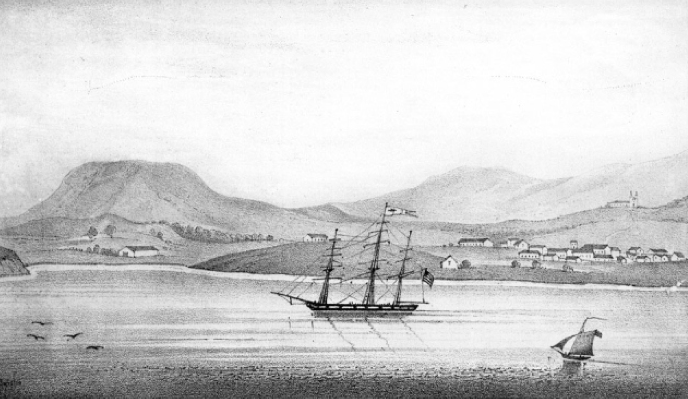Santa Barbara in the 1830s
 I've been reading through Richard Henry Dana's Two Years Before the Mast (published in 1840), in an effort to understand what an easterner might have envisioned when thinking about the West Coast. Dana, as you remember from previous posts, sought adventure and a cure for an eye ailment as a young man, so he left his life as an 1830s budding Boston elite and headed to sea as a common sailor. He was well seasoned by the time he rounded the Cape and headed north up the Pacific Coast. The book - written using his journal accounts - was not an immediate success. But by the 1870s, it was one of a few books that helped form the definitive image of California before American conquest. It's a fascinating tale, really. I recommend it for all.
His descriptions of going ashore are rich and detailed. I found his look at Santa Barbara of personal interest - I went to high School there (SMHS ROYALS '85 WOOHOO!) and still have a number of friends living in the vicinity. So here you go - you SB folks might recognize a few things...
I've been reading through Richard Henry Dana's Two Years Before the Mast (published in 1840), in an effort to understand what an easterner might have envisioned when thinking about the West Coast. Dana, as you remember from previous posts, sought adventure and a cure for an eye ailment as a young man, so he left his life as an 1830s budding Boston elite and headed to sea as a common sailor. He was well seasoned by the time he rounded the Cape and headed north up the Pacific Coast. The book - written using his journal accounts - was not an immediate success. But by the 1870s, it was one of a few books that helped form the definitive image of California before American conquest. It's a fascinating tale, really. I recommend it for all.
His descriptions of going ashore are rich and detailed. I found his look at Santa Barbara of personal interest - I went to high School there (SMHS ROYALS '85 WOOHOO!) and still have a number of friends living in the vicinity. So here you go - you SB folks might recognize a few things...
[quote]
The bay, or, as it was commonly called, the canal of Santa Barbara, is very large, being formed by the main land on one side, (between Point Conception on the north and Point St. Buena Ventura on the south,) which here bends in like a crescent, and three large islands opposite to it and at the distance of twenty miles. This is just sufficient to give it the name of a bay, while at the same time it is so large and so much exposed to the south-east and north-west winds, that it is little better than an open roadstead; and the whole swell of the Pacific ocean rolls in here before a southeaster, and breaks with so heavy a surf in the shallow waters, that it is highly dangerous to lie near to the shore during south-easter season; that is, between the months of November and April.
The beach [where we put ashore] is nearly a mile in length...and of smooth sand. We had taken the only good landing place, which is in the middle; it being stony toward the ends. It is about twenty yards in width from high-water mark to a slight bank at which the soil begins, and so hard that it is a favorite place for running horses. It was growing dark, so that we could just distinguish the dim outlines of the two vessels in the offing; and the great seas were rolling in, in regular lines, growing larger and larger as they approached the shore, and hanging over the beach upon which they break, when their tops would curl over and turn white with foam, and , beginning at one extreme of the line, break rapidly to the other, as a long cardhouse falls when the children knock down the cards at one end.
[/quote]
I sort of fell like a road trip now.
With compliments,
Keith